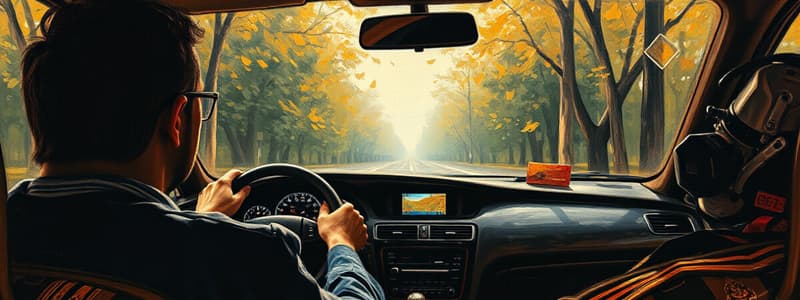Podcast
Questions and Answers
What is a place to go in case of possible conflict?
What is a place to go in case of possible conflict?
escape path
What is the process of searching critical areas in a regular sequence called?
What is the process of searching critical areas in a regular sequence called?
orderly visual search pattern
What are the six areas of space around the vehicle called?
What are the six areas of space around the vehicle called?
zones
What is the space your vehicle will occupy called?
What is the space your vehicle will occupy called?
What is a space where you can drive free of restrictions to your line of sight or path of travel?
What is a space where you can drive free of restrictions to your line of sight or path of travel?
What is an area of space around the vehicle that is free of restrictions, hazards, and conflicts called?
What is an area of space around the vehicle that is free of restrictions, hazards, and conflicts called?
What is all of the area that is visible to the driver when looking straight ahead called?
What is all of the area that is visible to the driver when looking straight ahead called?
What is a space not open because of restrictions in your line of sight or path of travel called?
What is a space not open because of restrictions in your line of sight or path of travel called?
What does it mean to give as much space as possible to the greater hazard?
What does it mean to give as much space as possible to the greater hazard?
How can a driver reduce risk by putting more space between themselves and the hazard?
How can a driver reduce risk by putting more space between themselves and the hazard?
What is the gripping power between the tire and the road surface called?
What is the gripping power between the tire and the road surface called?
What is the term for selecting and identifying only those clues for restrictions, hazards, or conflicts that are important to your driving task?
What is the term for selecting and identifying only those clues for restrictions, hazards, or conflicts that are important to your driving task?
What is the area far ahead in your path of travel and the area to the left and right called?
What is the area far ahead in your path of travel and the area to the left and right called?
What is the recommended searching area for identifying changes in your line of sight and path of travel?
What is the recommended searching area for identifying changes in your line of sight and path of travel?
What part of the field of vision surrounds the central vision?
What part of the field of vision surrounds the central vision?
What is the searching range where you need to get the final update of how you are controlling your intended path of travel?
What is the searching range where you need to get the final update of how you are controlling your intended path of travel?
What is the term for when a driver follows the process of an orderly visual search pattern?
What is the term for when a driver follows the process of an orderly visual search pattern?
What does it mean to adjust your speed in order to handle one hazard at a time?
What does it mean to adjust your speed in order to handle one hazard at a time?
What part of a field of vision allows you to see clearly and sharply?
What part of a field of vision allows you to see clearly and sharply?
What is the distance you can see ahead in the direction you are looking called?
What is the distance you can see ahead in the direction you are looking called?
Flashcards
Escape Path
Escape Path
A designated area for maneuvering to avoid conflicts.
Orderly Visual Search Pattern
Orderly Visual Search Pattern
A systematic method to scan critical areas while driving, ensuring no area is missed.
Zones
Zones
Six designated areas surrounding your vehicle that need continuous observation.
Path of Travel
Path of Travel
Signup and view all the flashcards
Open Zone
Open Zone
Signup and view all the flashcards
Space Cushion
Space Cushion
Signup and view all the flashcards
Field of Vision
Field of Vision
Signup and view all the flashcards
Closed Zone
Closed Zone
Signup and view all the flashcards
Compromise Space
Compromise Space
Signup and view all the flashcards
Minimize a Hazard
Minimize a Hazard
Signup and view all the flashcards
Traction
Traction
Signup and view all the flashcards
Selective Seeing
Selective Seeing
Signup and view all the flashcards
Target Area
Target Area
Signup and view all the flashcards
12-15 Second Range
12-15 Second Range
Signup and view all the flashcards
4-6 Second Range
4-6 Second Range
Signup and view all the flashcards
Peripheral Vision
Peripheral Vision
Signup and view all the flashcards
Central Vision
Central Vision
Signup and view all the flashcards
Line of Sight
Line of Sight
Signup and view all the flashcards
Predict (P)
Predict (P)
Signup and view all the flashcards
Identify (I)
Identify (I)
Signup and view all the flashcards
Study Notes
Escape Paths and Visual Searching
- Escape path: A designated area to maneuver if a conflict arises.
- Orderly visual search pattern: A systematic method of scanning critical areas while driving.
- Zones: Six designated areas surrounding the vehicle that need constant monitoring.
- Path of travel: The specific space your vehicle will occupy during movement.
- Open zone: A driving area free from obstructions that hinder visibility or movement.
Vehicle Space and Safety
- Space cushion: An area around the vehicle that is clear of obstacles, providing a safety buffer.
- Field of vision: The complete area visible to a driver when looking straight ahead.
- Closed zone: An area that is restricted due to obstructions affecting visibility or movement.
Risk Management Techniques
- Compromise space: Allocate more room to the greater hazard to ensure safety.
- Minimize a hazard: Increase the distance between yourself and potential threats to reduce risk.
- Traction: The friction between the tires and the road, crucial for vehicle control.
Observational Skills and Ranges
- Selective seeing: The ability to focus on relevant cues and ignore distractions.
- Target area: The area ahead that requires attention for safe driving.
- 12-15 second range: Recommended distance to scan for changes in the driving environment.
- 4-6 second range: The immediate area needing final checks before executing maneuvers.
Vision Types and Driving Decisions
- Peripheral vision: The area of vision surrounding the main line of sight, important for sensing movement.
- Central vision: The focused area of sight that provides clear detail.
- Line of sight: The distance visible ahead based on the driver's gaze direction.
IPDE Process
- Predict (P): Anticipate actions of other vehicles and potential hazards.
- Identify (I): Recognize obstacles, signs, and restrictions in your path.
- Decide (D): Choose an appropriate response to maintain safety.
- Execute (E): Carry out maneuvers such as braking, steering, or signaling.
Responses to Traffic Scenarios
- Recognize how to separate hazards by adjusting speed, changing lanes, or communicating with other drivers.
- Use your environment and visual cues to inform your predictions and decisions while driving.
Communication and Visibility Tools
- Use horns to alert nearby bicyclists and ensure visibility with high and low beam lights.
- Activate turn-signal lights when planning maneuvers, and maintain awareness of eye contact with other road users.
- Utilize appropriate taillights, parking lights, and hazard flasher lights in various situations to enhance visibility and safety.
Awareness of Surroundings and Vehicle Positions
- Stay alert to surrounding vehicles, pedestrians, and road conditions for informed decision-making.
- Adjust strategies based on proximity to other vehicles, including those parked or moving near intersections.
Studying That Suits You
Use AI to generate personalized quizzes and flashcards to suit your learning preferences.




